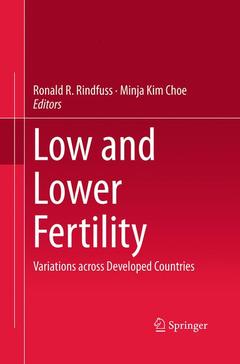Low and Lower Fertility, 1st ed. 2015 Variations across Developed Countries
Coordonnateurs : Rindfuss Ronald R., Choe Minja Kim

Ronald R. Rindfuss is a Research Professor in the Department of Sociology, Adjunct Professor in the Geography Department, and a Fellow of the Carolina Population Center at the University of North Carolina – Chapel Hill, and a Senior Fellow at the East-West Center, Honolulu, HI. He is Past President of the Population Association of America and a former Director of the Carolina Population Center. His research interests include fertility, population and the environment, migration and family demography.
Examines two distinct low fertility scenarios that have emerged in economically advanced countries since the turn of the 20th century
Explores how a country’s institutions, policies and culture shape its fertility level and pattern
Leading demographers compare fertility influences across high-income, highly-educated countries with advanced economies
Highlights the unique case of China which raises important questions about the importance of policy versus social and economic factors
Date de parution : 08-2016
Ouvrage de 188 p.
15.5x23.5 cm
Disponible chez l'éditeur (délai d'approvisionnement : 15 jours).
Prix indicatif 52,74 €
Ajouter au panierDate de parution : 10-2015
Ouvrage de 188 p.
15.5x23.5 cm
Disponible chez l'éditeur (délai d'approvisionnement : 15 jours).
Prix indicatif 52,74 €
Ajouter au panier


